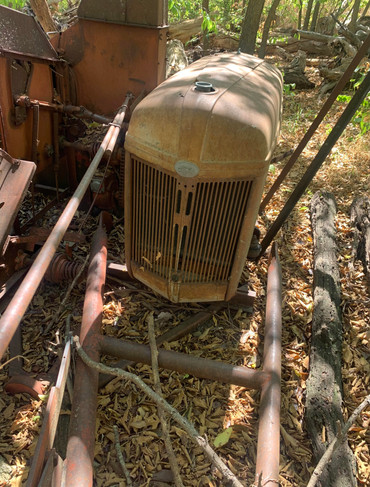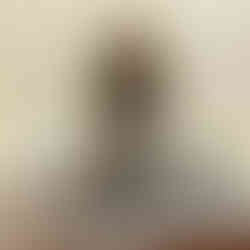Stories of art-making on an old dairy farm in Kansas
- alicecombs86
- Oct 14, 2022
- 4 min read
Hi there.
Came down with Covid this week. While I'm isolating, I thought I'd make use of my upside-down sleep schedule to write a little bit more in-depth about some art I worked on during a residency at Mother's Milk in Newton, KS. I was there September 10 to October 7, 2022.

The sunsets were brilliant, the sunflowers bright, and the grasshoppers abundant. I didn't notice the chonky grasshopper in this image until I uploaded my photos.
My main interest in coming to this residency was working with/making interventions on abandoned farm equipment. Within the first two days on the property, I decided the thresher/tractor (left) and the plow (right) would be the two I wanted to collaborate with.
The above three photos are stills from time-lapses I might compile someday. I had to bend and do a little dance with the thresher in order to make what I had in my head a reality. The aim was to create a level line 42" off the ground polished to a mirror finish.
Some notes about Thresher Horizon Line in no particular order:
I had Charles Ray's Tractor in mind. What would it have meant to move the thresher from its site? For one thing, it would have disrupted the rat nest that was most certainly in use.
Looking at vintage Ford tractor websites, I was able to find out that this particular tractor was probably from between 1947 and 1952--the postwar era when cash was flowing through the recently re-domesticated soldier population and many young men probably bought the shiniest newest equipment for their family's farm.
Why 42" high? Wheat grows between 3-4 feet high, and that's most likely what this thresher would've been processing.
Harvests in general are almost completely automated. 1-2 people can do more with modern combines than a whole village could before. But with the technological progress came the loss of the celebration and communal effort that happened with the harvest.
The horizon can represent newness. A polished metal surface can represent new technology. I think there is a tendency to expect that new technology will always be on the horizon, just waiting to be discovered to take care of all our problems. But it is at the expense of attention to the material reality of human/environment/thing interaction that exists in the present. I paid a lot of attention, at least to a few things for this month.


I had an extended picnic with this plow while polishing two ends of a solid bar that are nearly parallel planes to each other.
I imagine there is a chance that these two create an infinity mirror...
...alas, when I try to capture it, the camera gets in the way. It's only a theoretical infinity mirror. I think I'll call this intervention Theoretical Infinity Mirror for a Plow. Notes on Theoretical Infinity Mirror for a Plow in no particular order:
I think about how no-plow permaculture is in vogue as part of the restorative agriculture movement. So, here sits a plow. Not aerating the soil. Itself being aerated by ambient oxygen, lichen spores, and my own sandpaper. The plow will be here for a long time. I should give it something to do to pass the time. An infinity mirror would be fun. People seem to like infinity mirrors. But this infinity mirror is private to the plow.
I like that I "thwarted" the camera with this project. I think I have an adversarial relationship with photography. I hate that we rely so much on it. How can I do the bare minimum amount of photography and accurately communicate to people what I've been doing? I suppose sometimes it's not possible. I'm just having some alone time with things I find meaningful.

Drawing on this big rusty surface was an absolute joy. The concept, process, and finished look all felt so loaded with meaning. The yellow-orange color is nice too. Right now I'm calling it Ferrohatch Fence. Did this just come from me? Let's get in there and look at a couple details:
The little squiggly thing in the second image was particularly important. I'd come to call them "wire sprites" after the soot sprites from Miyazaki movies. Tangled wire pieces are all over the farm, marking temporary fixes or holding things that have since fallen.
This is the section of fence I based the drawing on:

The bent and shifted grid of the fence spoke to me of warped time, space, material. Each node was a coiled tiny hand. I thought of my friend's article about fences. I thought of how these are the material markers of borders and the material of the concept called private property.
I thought about making rust-scratch drawings while working on the thresher. Below is one of the first studies made on a rusty can near the thresher:

There are a few more process photos on my Insta.
Oh yeah, and I made this thing too:
I'm calling it Barb-ie Playset. LOL.
OK, wrapping it up with some fun stuff:
Left to Right: examples of many different barbed wire patterns in the Lindsborg old town square...also it looks like a face; Nelson and Gerry (who run Mother's Milk) took us to a Mennonite buffet where you could sample as many pies as you wanted (they were all delicious); Finally, the concrete sculptures of Oscar Gunnarson are all housed at the Old Mill museum in Lindsborg. They were sweet and quirky.
Writing and documentation with photography are my two least favorite activities, so this has been annoying and uncomfortable! I might never do it again.
Thanks for looking/reading,
-Alice
































Comments